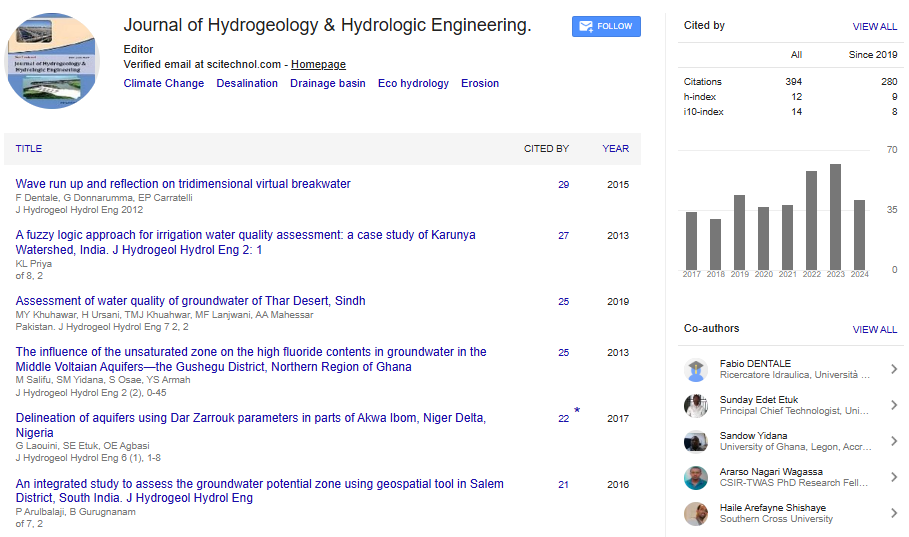Commentary, J Hydrogeol Hydrol Eng Vol: 13 Issue: 6
Sustainable Management of Water Resources: Balancing Human and Environmental Needs
Omar Khaled*
1Department of Hydrology, University of Melbourne, Melbourne, Australia
*Corresponding Author: Omar Khaled,
Department of Hydrology, University of
Melbourne, Melbourne, Australia
E-mail: khaledo34@gmail.com
Received date: 26 November, 2024, Manuscript No. JHHE-24-154124;
Editor assigned date: 28 November, 2024, PreQC No. JHHE-24-154124 (PQ);
Reviewed date: 12 December, 2024, QC No. JHHE-24-154124;
Revised date: 20 December, 2024, Manuscript No. JHHE-24-154124 (R);
Published date: 27 December, 2024, DOI: 10.4172/2325-9647.1000354.
Citation: Khaled O (2024) Sustainable Management of Water Resources: Balancing Human and Environmental Needs. J Hydrogeol Hydrol Eng 13:6.
Description
Water is a precarious resource for sustaining life, ecosystems and economic development. However, the increasing demand for water, coupled with climate change and pollution, poses significant challenges to its availability and quality. The management of water resources has become a central concern for policymakers, scientists and communities worldwide. This article discovers strategies for sustainable water resource management, focusing on balancing human consumption with ecological preservation.
Water resources include surface water, such as rivers, lakes and reservoirs, as well as groundwater found beneath the Earth's surface. These resources are vital for agriculture, drinking water, sanitation, energy production and industrial processes. Beyond human needs, water sustains diverse ecosystems, supporting aquatic and terrestrial life. The availability of clean and reliable water directly impacts public health, food security and economic stability.
Challenges in water resource management
Overextraction: Overuse of water for agriculture and industry depletes groundwater reserves, leading to issues like land subsidence and reduced river flows.
Pollution: Industrial waste, agricultural runoff and untreated sewage contribute to water contamination, rendering resources unfit for consumption and damaging ecosystems.
Climate change: Changing weather patterns result in altered precipitation levels, increased frequency of droughts and flooding, further stressing water availability.
Population growth: Expanding populations increase water demand, especially in urban areas, where infrastructure often lags behind.
Strategies for sustainable management
Integrated Water Resource Management (IWRM): IWRM promotes the coordinated development and management of water, land and related resources to maximize economic and social welfare without compromising ecosystems.
Rainwater harvesting: Collecting and storing rainwater for use during dry periods reduces dependency on traditional water supplies. This method is particularly effective in arid and semi-arid regions.
Water recycling and reuse: Treating wastewater for reuse in irrigation, industrial processes, or even potable use can significantly reduce freshwater demand.
Policy and regulation: Governments play an essential role in regulating water extraction, ensuring equitable distribution and protecting water bodies from pollution. Effective laws and enforcement mechanisms are essential.
Community involvement: Engaging local communities in water conservation practices adopts charge and enhances the success of management initiatives.
Advancements in technology are revolutionizing water management. Tools like remote sensing and Geographic Information Systems (GIS) enable efficient monitoring of water resources. Smart irrigation systems reduce water waste in agriculture, while desalination technologies provide alternatives for water-scarce regions. Additionally, data-driven models assist in predicting and mitigating the impacts of climate variability on water availability.
Countries across the globe have implemented innovative solutions to address water challenges. For instance, Singapore's NEWater initiative recycles wastewater into high-quality drinking water, demonstrating the potential of technology and policy in water management. In contrast, India's Jal Shakti Abhiyan emphasizes water conservation and harvesting at the grassroots level, showcasing community involvement.
Conclusion
Sustainable water resource management requires a multifaceted approach that incorporates technological innovation, policy frameworks and active community participation. Balancing the needs of human populations with environmental sustainability is a complex but achievable goal. By adopting integrated strategies and development global cooperation, we can ensure that water remains a resource for future generations while preserving the ecosystems that depend on it.
 Spanish
Spanish  Chinese
Chinese  Russian
Russian  German
German  French
French  Japanese
Japanese  Portuguese
Portuguese  Hindi
Hindi 
